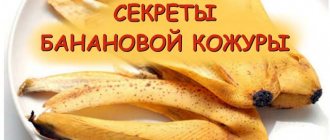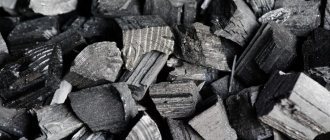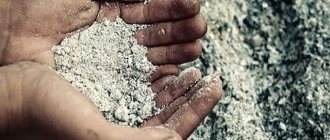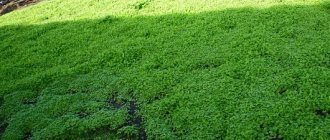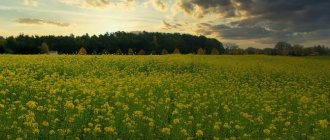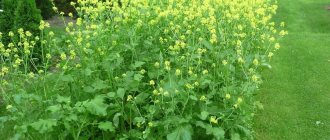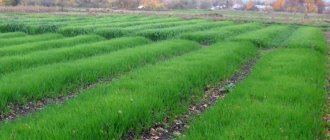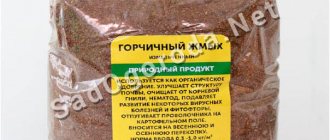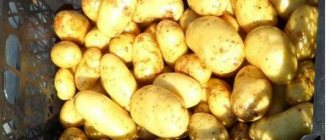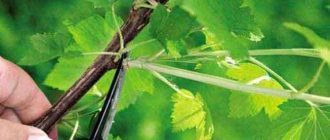How and where does mustard grow?
The mustard we are familiar with came from Asia (India), but some species originate from North Africa, as well as from the Mediterranean. Over the centuries, people have been able to adapt the plant to our harsh climatic conditions, so that now mustard can be found in the wild even in the coldest regions, but it is rarely used there for food purposes, mainly for agricultural needs.
Some varieties are very heat-loving, such as black mustard, which some gourmets and gardeners call French mustard. It came to us from the Mediterranean and requires richer soil. In these regions, the plant is grown for gastronomic purposes.
Description
Leaf (or salad) mustard is a spicy annual leafy plant belonging to the Cruciferous family. This annual can be immediately noticed in the garden thanks to its large soft green leaves, the shape of which can be different. All foliage is covered with fine pile, and the edges of a number of varieties are wavy. The height of mustard is 0.3 m, and for Japanese species it is 0.5 - 0.6 m. A photo of the plant (leaf mustard) can be seen below.
The structure of mustard
The country where this plant appeared is China. And from this state, over time, mustard began to spread throughout the world. In the national cuisines of Asian countries such as Japan, India and China, salad mustard is used very widely as a separate dish, as well as as an additive to salads and many national dishes.
In our country, unfortunately, mustard foliage is not yet used as widely as it should be.
Chemical composition and calorie content
Quite a few varieties of mustard are known, but their chemical composition and nutritional value are almost the same. Do not forget that all species have the same ancestor, which means that the genetic code of all these plants is the same. Here is a list of components that make up our usual seasoning:
- essential oil;
- proteins;
- carbohydrates;
- fats;
- alimentary fiber;
- starch;
- sugar;
- myronic acid (salt derivative).
Mustard leaves, especially young ones, are rich in vitamins, the main of which belong to groups E and B. They also contain a decent amount of mineral salts.
The nutritional value of mustard directly depends on the form in which it is present. If we are talking about a fresh plant that has not yet begun to wither, then the calorie content is 162 kcal per 100 grams of product. If mustard is already prepared as a seasoning, then the value is lower - 67 kcal. However, the plant acts as an auxiliary “dish”, so with its help it will still not be possible to satisfy the daily need for calories, proteins, fats, carbohydrates and vitamins.
When to mow
Mustard, which is planned to be planted in the ground as green manure, begins to be cut or mowed in the budding phase or at the beginning of flowering. At this time, the stems and leaves of plants have not yet become coarse, are filled with nutrients and juices, and are easily decomposed. Young mustard can be planted in the ground without mowing, digging up the beds along with the growing green manure. The roots remaining in the ground will ensure the safety of the surface layer and protect it from erosion.
Read how to choose a lawn mower for mulch HERE
Types of mustard
Mustard has only three varieties. Humanity has long mastered the production and use of the following plant species:
- White mustard. Despite the “telling” name, its color is yellow and very rich. People who are accustomed to spicy seasonings may not like it - you can easily spread it on bread and eat it in the form of sandwiches.
- Black (French). Even from the name you can understand its European origin. As mentioned above, the plant is quite heat-loving, so it grows best in Italy and the southern provinces of France. The most famous and exquisite seasonings are made from black mustard.
- Sareptskaya (Russian). Other names: Chinese, brown, Indian. Grows well in the steppes of the Volga region and Ukraine. Good harvests are also harvested in Central Asia. In terms of culinary qualities, it resembles the black variety, but has a more “vigorous” aroma. It is this mustard that is sold in stores in the form of yellow powder.
Brassica nigra Koch, Brassica alba Boiss, Brassica juncea Czern
This is where the natural varieties of mustard end. All other varieties are subspecies of these three main plants. It is from them that such famous seasonings as Dijon “cream”, fruit mustard and Creole delicacy are made.
Beneficial features
Mustard is a storehouse of useful microelements. In total, the effect on the body looks something like this:
- vitamins E and B promote the breakdown of proteins, carbohydrates and fats, facilitating their rapid and effective absorption;
- calcium normalizes salt metabolism, while simultaneously ensuring strong teeth and bones;
- acids of organic origin help the process of formation of soft tissues;
- potassium strengthens the heart;
- iodine eliminates hormonal problems;
- iron promotes productive blood formation.
Taken together, all these substances support human health in an acceptable form by strengthening major organs and systems, as well as a beneficial effect on the immune system. And that's not all: mustard is a good natural antiseptic that can destroy some bacteria and viruses, although not in such quantities as medicinal antibiotics.
Interesting! In the mid-twentieth century, a group of enthusiasts conducted surveys of centenarians in the Caucasus. The goal was to find out the details of their diet. And almost every one of them said that they often eat mustard, using it as a seasoning. By the way, many were a little over 100 years old!
Harm and contraindications
If there are no health problems, then the seasoning can cause harm to the body only if consumed unwisely. A large amount of product, instead of disinfection, will bring many problems to the stomach in the form of irritation and food burn, which will result in indigestion. Main contraindications for consuming mustard:
- gastritis and stomach ulcers;
- nephritis;
- inflammation of the stomach;
- problems with the large intestine.
It is also not recommended for allergy sufferers to eat mustard. The product contains a lot of essential oils; in rare cases, such a blow to the body ends in anaphylactic shock; in such a situation, only emergency medical care can help.
Important! If you are allergic to mustard, then you need to exclude most of the products that contain it from your diet, for example, mayonnaise and sauces.
Proper care of salad mustard
Caring for plantings is not particularly difficult, so the crop can be recommended to beginning gardeners, as well as summer residents who come to their garden once a week at most.
- Plants in garden beds require moderate watering, so one watering of the soil per week is sufficient. Stagnant water is harmful to salad mustard, and high humidity leads to the appearance of fungal diseases and a significant deterioration in yield indicators.
- When growing crops in the summer, when there are long daylight hours, it is recommended to darken the beds by any available means, for example, slate, roofing felt, dark film. Plantings should be placed in the shade of a fence or near large, dense trees.
- It is recommended to weed the beds once a week to remove weeds. This helps prevent the occurrence of infectious diseases and solves problems with insect pests. The crop receives from the ground all the minerals and components it needs, which are quickly absorbed and subsequently the salad mustard bears fruit well, allowing it to grow the maximum yield.
Application area
Cooking
The main role of mustard in the food industry is as a seasoning. It is added to soups, meat dishes, and salad dressings. Some varieties, such as Dijon, are spread on bread instead of butter. In addition to the ability to give different dishes a special taste, mustard has the property of a preservative and also helps maintain the consistency of some products.
Medicine
Mustard plasters, plasters based on this plant and some other accessories have been around for decades. They speed up the process of eliminating colds and serve as a means of preventing them. It also helps relieve attacks of radiculitis and rheumatism, and also improves blood circulation. Medicines made from mustard are indispensable in the treatment of colds - you can use it to soothe your feet, make compresses, and even put it in socks “to warm up.”
Cosmetology
Skin and hair are the main areas of use of mustard by fashionistas, and other people who want to look young and beautiful. The plant has an “irritating” property, which stimulates the formation of new hair follicles. Thus, mustard slows down baldness, and in some cases allows you to restore hair. Wrapping with mustard powder eliminates acne and irritation, and also helps normalize fat balance.
Hair mask contains:
- two tablespoons of powder;
- one egg yolk (raw);
- two teaspoons of sugar.
All components are mixed, the resulting “gruel” is evenly distributed throughout the hair. Keep the mask on for no more than 40 minutes.
Mustard mask for hair strengthening and growth
The face mask contains:
- 5 tablespoons mustard powder;
- 10 ml lemon juice;
- 2 ml jojoba oil.
The mixture is applied to clean skin, after 7 minutes it is washed off with plenty of water.
Mustard mask to relieve inflammation
The wrapping mixture provides a more complex recipe:
- a glass of warm milk;
- a teaspoon of cinnamon;
- a tablespoon of mustard powder;
- 2 tablespoons starch.
The ingredients are mixed to form low-fat sour cream. Gauze is soaked in the resulting mixture and wrapped around problem areas of the body. Polyethylene is “laid” on top and warm clothes are put on. You can’t keep this mask on for more than half an hour!
Life
Mustard is known for its ability to dissolve almost any stain and break down fats. This property is used by housewives in washing dishes and laundry. It goes without saying that you should use mustard powder, and not a tasty seasoning. It is added directly to the drum of the washing machine, sprinkling it on dirty laundry (50 grams will be required). When washing by hand, you will need 30 grams of powder per liter of water. The solution must be infused for 3 hours, after which things are rinsed in it. Mustard also absorbs unpleasant odors well. If you put the yellow powder in a closet (wrapped in a rag), the “aroma” of mustiness and dampness will go away on its own, and quickly.
Agriculture
Mustard is pungent and has antibacterial properties. Some insects are afraid of her. It is not surprising that in the gardening sector it is used for pest control. It is permissible to use only seeds that are buried in the ground. In addition to antiseptic properties, they have the ability to accumulate nitrogen, which is very useful for the root system of cultivated plants.
Method of preparing spices
Our ancestors became acquainted with mustard around 1765, thanks to the efforts of Catherine II. She was a big fan of overseas spices and came up with recipes herself. Here is one example of such a “classic”:
- 100 grams of mustard powder (in the old days they used ground grains, essentially the current product is the same);
- half a teaspoon of sugar;
- 10-15 grams of salt;
- a glass of warm water;
- 30-40 ml of vegetable oil, preferably sunflower.
Recipe for Russian spicy mustard
Powder is poured with water (not boiling, otherwise the product will lose its pungency) and stirred thoroughly. The proportion should be approximately ¼. Then you should wait until liquid appears on the surface of the pulp. Drain it and add the rest of the ingredients. Stir thoroughly again and put it in the refrigerator. After a few hours you can enjoy the seasoning.
Another recipe allows you to get a more fragrant and less pungent seasoning, but its preparation will require more ingredients:
- 60 ml vegetable oil;
- 30 mg sugar;
- 15 mg salt;
- 120 ml 3% vinegar;
- bay leaf (one);
- two peas of cloves;
- a pinch of cinnamon;
- half a tablespoon of mustard powder;
- 120 ml water.
Salt, sugar and spices are poured into water, which is brought to a boil over medium heat. Then add mustard powder to the liquid and stir. Add the remaining ingredients to the resulting slurry and mix until smooth. After cooling, you can immediately use the seasoning.
Tender mustard recipe
How to choose quality mustard and where to buy it
You can buy a good product anywhere. Sometimes large supermarkets sell an outright surrogate, and in markets they sell an excellent seasoning. You need to look not at the place of purchase, but at the appearance of the mustard, its packaging and composition indicated on the label. The fewer ingredients the better. Even the vinegar from the recipe described above is poorly suited to industrial mustard. Therefore, give up:
- mustard sauces;
- seasonings in bags and plastic packaging;
- product sold by weight.
Photo taken from pinterest.com
It is recommended to buy only mustard that is packaged in sealed glass jars. But even in this case, look at the expiration date - expired seasoning, even if it does not lead to poisoning, will definitely ruin the taste of the food.
How to sow
Before sowing mustard, prepare the soil and treat the seeds. For one hundred square meters, when sowing by hand, use from 150 to 400 g of seeds. Seeds must be treated to avoid the appearance of cruciferous flea beetle. The drug “Ophtalon” is used to disinfect seeds. The product is effective for a month after germination. In addition, white mustard plantings can suffer from cabbage aphids, bugs, white butterfly larvae, and secretive proboscideans. When pests appear, seedlings are treated with insecticides “Volaton”, “Zolon”, “Karate”, “Fastak”, “Decis”.
Preparing the soil for sowing green manure begins with loosening the soil, removing weeds, and leveling the top soil layer. Before sowing, the soil is compacted to provide the necessary soil structure that does not allow the seeds to fall to great depths, and it is moistened. The seeds are sown to a depth of 2-3 cm. After this, the soil is rolled over the seeds or a rake is used to cover the seeds with soil. The structure of the soil above the crops should be finely lumpy.
The second planting method involves sowing seeds on the surface of the soil and then covering the seeds with a thin layer of soil. In this case, there is a risk of birds pecking at the seeds. The area with seeds should not be allowed to dry out; uniform watering is necessary. In this case, the shoots will be friendly and fast. Sprouts are also demanding of soil moisture. Mustard grows best on fertile black soil. Does not like salt marshes, clayey and acidic soils.
Growing mustard at home
Russian mustard (Sarepta) is optimal for middle latitudes. It takes root well in any type of soil and can withstand sudden temperature changes. The only limitation is that the plant does not like very wet soil, so wetlands are not suitable for mustard. The greenhouse can only be used in the spring, immediately after planting. The fact is that the optimal temperature for growing is 18 degrees; if it is warmer, the leaves of our crop will quickly become coarse.
For mustard, a separate bed should be allocated, which is best sown in mid-March if a greenhouse is used, or in mid-April in open ground conditions. The distance between the seeds should be maintained at about 22 centimeters, and they should be planted to a depth of 1.5 cm. Excessive watering is not necessary - irrigate immediately after planting, and continue to water a little every 2-3 days. The first shoots will be ready for harvest in 15-20 days, depending on the weather. These pours are great in a salad, try them, you won’t regret it!
How to grow on a windowsill
Currently, many varieties of salad mustard have been bred; they grow well not only in open beds, but also in pots. To grow fresh, healthy greens on the windowsill, you can choose the following varieties:
- freckle;
- prima;
- wave;
- ditty;
- Red hill.
You can use flower pots 20-30 cm deep or other suitable containers of the same size for growing. A universal soil is suitable for growing. You can take 0.5 kg of sand and peat per kg of soil and mix everything well.
A day before sowing, water the soil well. Seed the seeds to a depth of no more than 0.5 cm. Place the container on the window, cover with film, and on the seventh day shoots will begin to appear.
Recommendation : seedlings are not afraid of low temperatures and grow quite quickly on the windowsill even in winter.
The seedlings need to be watered after 1-2 days, avoiding drying out and excessive waterlogging of the soil. You can harvest greenery as soon as the bushes reach the age of 25 days. The younger the leaves, the softer and more pleasant their taste.
